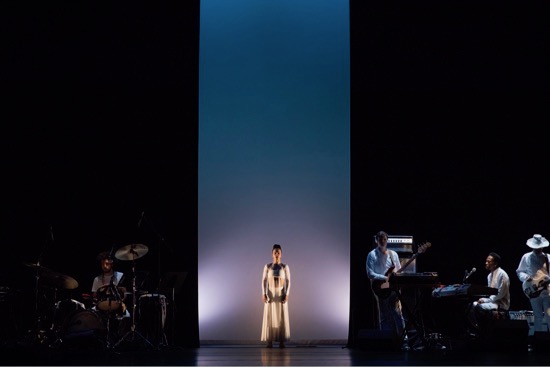
I think I first saw Ronald K. Brown’s Grace twenty years ago when it was brand new and performed by the Alvin Ailey American Dance Company. Last week I saw it again, when it opened the 2019 SummerScape Festival at Bard College, this time performed by the choreographer’s own group: Ronald K. Brown/Evidence: A Dance Company. The work itself hasn’t changed much, but the context has. This year’s SummerScape was inspired by the life, times, and environment of the Viennese composer Erich Wolfgang Korngold, who began his career as a child prodigy in classical music and ended it in Hollywood, writing music for movies from 1934 to his death in 1956. Grace opens and closes with Duke Ellington’s “Come Sunday” from his 1942 Black, Brown and Beige suite sandwiching Roy Davis, Jr.’s “Gabriel” and Fela Anikulapo Kuti’s “Shakara.” A possible connection with Korngold? He and Ellington were contemporaries, and, beginning in the 1950s, the latter too wrote film scores.
The earlier Grace, whether performed in 1999 by the Ailey company or revised for Brown’s own company in 2003, was accompanied by recorded music. At Bard, the musicians are live and onstage, on either side of the tall, luminous opening in the curtains at the back (Brenda Gray has redesigned William H. Grant’s lighting). Keyboard player Jake Sherman and percussionist Abraham Rounds sit stage left. Stage right houses keyboard player and music supervisor Peven Everett, Chris Bruce (guitar), Dan Chmielinski (bass), Julius Rodriguez (keyboard), and and Corey Wallace (trombone). The sound gains tremendous power, even though the sung words by various of the musicians don’t always come through clearly.
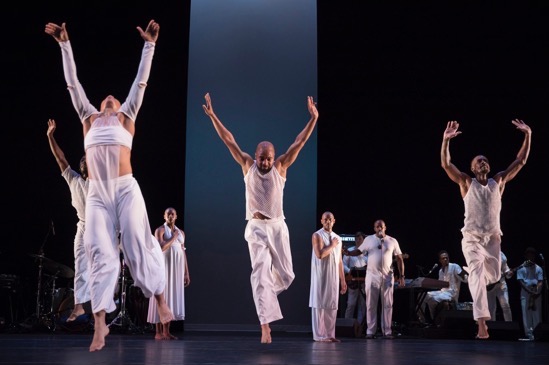
The musicians’ presence helps transform the people onstage into a congregation. If they dance in unison—and they do quite a lot—I don’t think of them as “performing” for us, but as joining in dance the way singers in church raise their voices together. These dancers are individuals too, uniform neither in age nor training. Associate Artistic Director Arcell Cabuag joined Evidence twenty-two years ago. Keon Thoulouis danced with it for seven years, beginning in 2001 and returned to it in 2014. Annique Roberts joined it nine years ago. Matthew Rushing, who became a member of the Ailey American Dance Company in 1992, has guested with Brown’s company since 2014. Kirven Douthit-Boyd, a member of AAADC for eleven years, is also a guest artist. Randall Riley, having been a part of Evidence for two seasons, returns as a guest too. This is the first season for three other dancers, and four more are apprentices. (I wouldn’t mind being a fly on the backstage wall.)
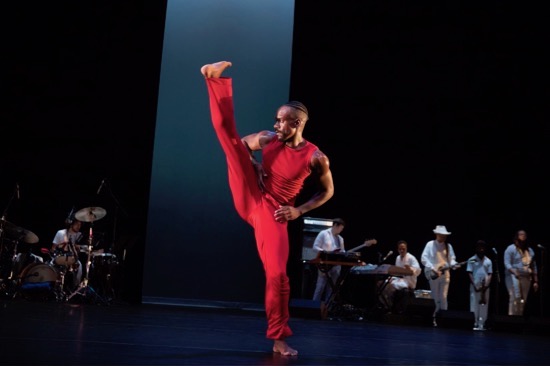
Roberts ignites the dance alone. Entering through the threshold in the back curtain, she walks toward us like a queen or a priestess. She doesn’t then follow every musical phrase; thrashing and stepping and whipping and softly spinning, she’s uttering her own prayer. Some of the performers wear white clothes (designer: Ibiwunmi Omotayo Olaiya), none exactly alike; some are dressed in red. Although three men in white and three in red may dance in unison, the costuming seems to stand for something, because by the time the dance ends and all file out through that portal at the back, everyone is dressed in white. Maybe it’s that, in life, saints and sinners aren’t always identifiable as such.
Whether they’re rejoicing or expiating, lord, how they all dance! Brown founded his first company when he was twenty-one, and all that he knows of ballet, modern dance, and African forms has been woven and twisted together into his choreography and somehow Brownized. The dancers spin, leap, and dig their steps into the floor or slap it with their feet. Their hips are mobile; so are their upper bodies. Their arms fly or gesture. They’re not intent on “showing” us all this, but delving deeply, rhythmically into the movement as if they’re trying to make sense of it.
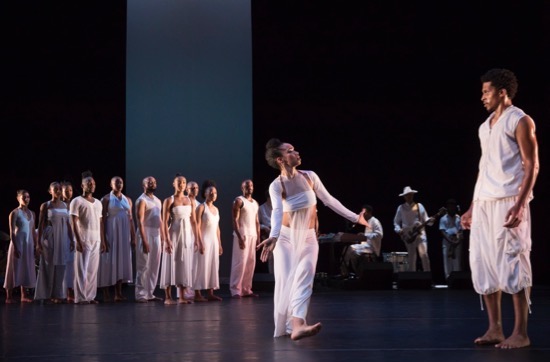
They come and go; they break out into brief solos. And, near the end, when they’re all dressed in white, and Gordon Chambers has arrived to sing another version of “See My People Through,” tall Riley seems to have doubts. Does he belong with the throng that stands watching him? Roberts confronts him, dances at him. Of course he belongs. Together, the dancers all process in a calm orderly way through that portal at the back, as if it were a church door and the service had ended. Amen.
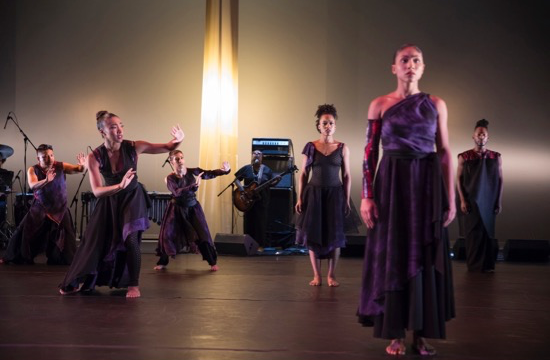
Grace shared the program with Brown’s new and shorter Mercy, a SummerScape commission. The composer, musician, and singer is Meshell Ndegeocello. She and Brown met at Bard, where she was performing earlier and began a collaborative process. Behind the five fabric pillars lurk equipment for electrified music. She plays electric bass and sings. Percussionist Rounds shifts between drums and a vibraphone, and Sherman mans a Fender Rhodes.
For this, the costume designer known familiarly as Wunmi has dressed the dancers in black tinged with purple and vice versa. Grace is a state we may or may not achieve. Mercy is something we bestow or beg for. “Have mercy on me,” sings Ndegeocelllo after the drums have begun. And formal though the dance’s structure is, those who enter and leave the stage, join and separate, need that compassion.
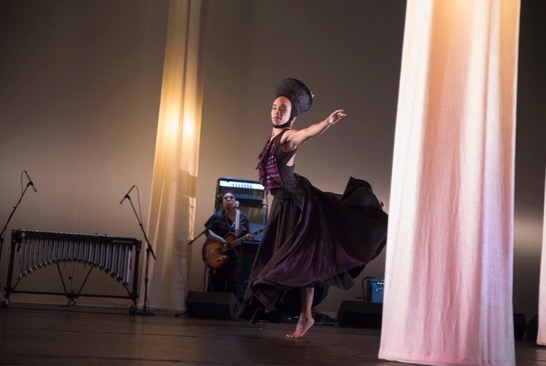
This dance too begins with a solo by Annique Roberts, but it’s less calm than the one she performed in Grace. So are the gestures and positions the dancers assume. One of them seems to open invisible doors or to raise their hands in surrender. At other times, the image is that of a person beinghanged — one arm stretched high and his/her head fallen to the side. They kneel, bowed over, their hands clasped behind their backs. We imagine them hit. But none of this is pure pantomime; it’s part of the dancing and the stillness that punctuates it.
Bit by bit, the “pillars” lift. “Look at all the light I bring,” sings Ndegeocello. As the music rises and thins out and the light fades, all the performers raise their voices. Asking for mercy or grateful for it having been granted.

Wonderful review, as usual!